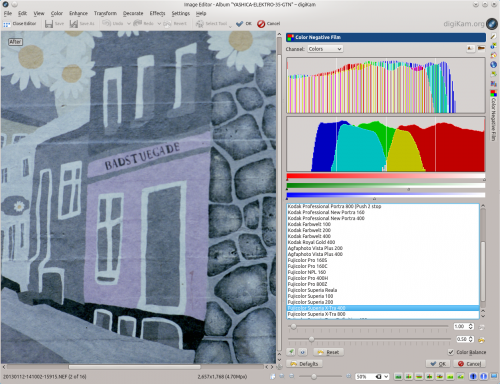Digikam/Negatius
Processar negatius de pel·lícula amb digiKam
Transcrit des de l'article d'en Dmitri Popov, el 29 de gener de 2013
Mentre que digiKam és sobretot una aplicació per al processament i organització de fotografies digitals, també compta amb eines per a treballar amb els negatius.
Abans de poder processar negatius en digiKam, cal digitalitzar-los. Si no teniu accés a un escàner de pel·lícules o un laboratori que ofereixi serveis d'escanejat, la podeu digitalitzar amb una càmera rèflex digital (a la web hi ha un munt de guies d'aprenentatge sobre com fer-ho). La resta del procés se suposa que utilitzeu la darrera manera per a digitalitzar els negatius.
Obriu un fitxer RAW que contingui una negatiu de pel·lícula a l'editor (escolliu l'opció o premeu la tecla F4). Retalleu el fitxer original i apliqueu la correcció de lents si és necessària. Després escolliu per a transformar el negatiu en una imatge positiva. En cas de treballar amb el color negatiu, el més probable és que la imatge convertida requereixi d'alguns ajustaments addicionals. En primer lloc, és probable que la imatge convertida tingui un to blau fort. El millor camí per eliminar-lo és utilitzar l'eina de correcció automàtica de digiKam. Escolliu l'opció i seleccioneu una de les predefinicions. En molts casos, els o predefinicions fan una bona feina en corregir els colors. Si els colors encara es veuen una mica apagats, els podeu ajustar encara més utilitzant l'eina .

The Invert feature in combination with an Auto-Correct preset provides a quick-and-dirty way of converting negatives, but digiKam has another tool designed specifically for processing color negatives. To access it, choose the command. The Color Negative Film interface contains several handy features that can help you to convert the negative and tweak the resulting image. While the Invert tool uses a generic profile for converting negatives, the Color Negative Film interface offers film profiles for many popular film types. So the first step is to select the appropriate profile. For better results, try to enable the option, too. If the used film is not in the list, you can use the profile as a fall back.
Although choosing the matching film profile may yield a better result, the converted image may still require some work. In most cases, you may need to adjust the white point to remove the remaining blue tint. You can do this either manually or automatically using the appropriate buttons. Usually, the automatic white point adjustment does the job, but the resulting image needs to be brightened up by adjusting the slider.
